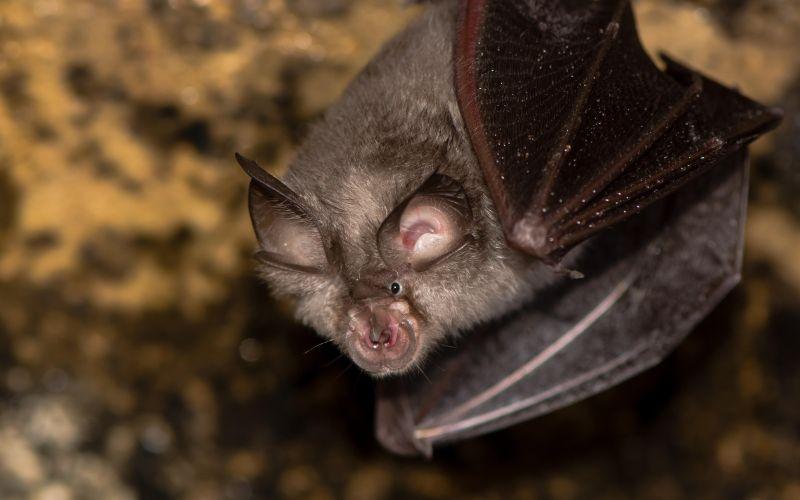
What Are Their Characteristics?
The greater horseshoe bat has a life expectancy of 30 years, and measures at 57mm - 71mm (the size of a small pear) which makes it one of the larger bat species in the UK. Their weight can vary between 17g (weight of a compact disc) and34g (weight of a lightbulb) with a wingspan of 350mm - 400mm.
When roosting, the bats shroud themselves with their wings. They also benefit from broad, round wings which enable them to manoeuvre easily in tight spaces and pick insects off surfaces by hovering over them.
Although it’s widely believed that all bats do this, greater horseshoe bats, and their smaller relatives, the lesser horseshoe bats, are the only species in the UK to hang from their feet - which makes them easy to recognise!
Greater horseshoe bats are born weighing only 6g with greyish fur, which becomes brown and reddish once they reach adulthood. The female bats mature at 3 years old, and may not breed every year. For breeding bats, mating season is usually in autumn, but can also occur in late winter and spring.
As with many bat species, males mate with several female greater horseshoe bats, but females only mate with the one male. Females mate with the same male over several years, so pups born in different years can be full siblings. This contributes to the cohesiveness of the female group.
Greater horseshoe bats are a vocal species with a distinctive warbling call on heterodyne bat detectors, on a frequency of 82 kHz. You can listen to it here.
Where Can They Be Found?
Formerly cave dwellers, the largest numbers of greater horseshoe bats habitats are in the old mines, roofs, large old buildings, and caves of Gloucestershire, Wales, Wiltshire, Dorset and Somerset, and Devon.
South Hams (Devon), has the greatest population of greater horseshoe bats in the UK. It is also believed to be the home of the largest maternity roost in the UK and Europe.
Grazed pastures and ancient woodlands are also very important habitats for the bats as this is where they hunt for their food.
What Does Their Diet Consist Of?
The bats enjoy a diet of chafers, dung beetles, noctuid moths, crane flies and caddis flies. Unfortunately, because of the overuse of insecticides, this species suffers from a lack of food supply.
A study on ivermectin (a type of insecticide) treatments in cattle found that it reduced the number of insects found in cow pats, compared to those from animals who had not been treated. In turn, this reduces a major source of food supply for the bats.
The greater horseshoe bat hunts for their prey in rural environments which include pastures, farmlands, parkland, woodland and scrub. Flying low for insects, the bats also look out for prey whilst strategically hanging off branches.
How Can We Help Protect Them?
Sadly, since the last century, the population of greater horseshoe bats has fallen by over 90%, which has made them a rare species. This is due to the disturbance of roosts, overuse of insecticides and pesticides, the loss of permanent pasture through intensive farming, and light pollution at night.
In some areas of the UK, street lights are turned off at certain times of the night to allow bats to hunt. It has been found that bats will actively do anything to stay away from light, which can lead to exposure to predators and restricts their ability to hunt.
This species is also highly affected by any disturbance of their nursery and winter roosts.
To prevent further decline of the species:
- Take special care to protect their roosts
- Keep their entrance holes clear
- Keep feeding habitats and food sources free of pesticides and insecticides
- Cut down on light pollution to allow bats to hunt properly at night
Want to help conserve this species? We stock a wide range of equipment for bat workers and school ecology which we’ll ship out to you with the fastest possible delivery. If you’d like to know more about any of our products, please don’t hesitate to contact us.
Facts source:
http://www.bats.org.uk/data/files/Species_Info_sheets/greaterhorseshoe.pdf
https://link.springer.com/article/10.1007%2Fs00436-006-0240-x
http://www.bats.org.uk/publications_download.php/344/Greater_horseshoe_Darren_Maynard.wav


